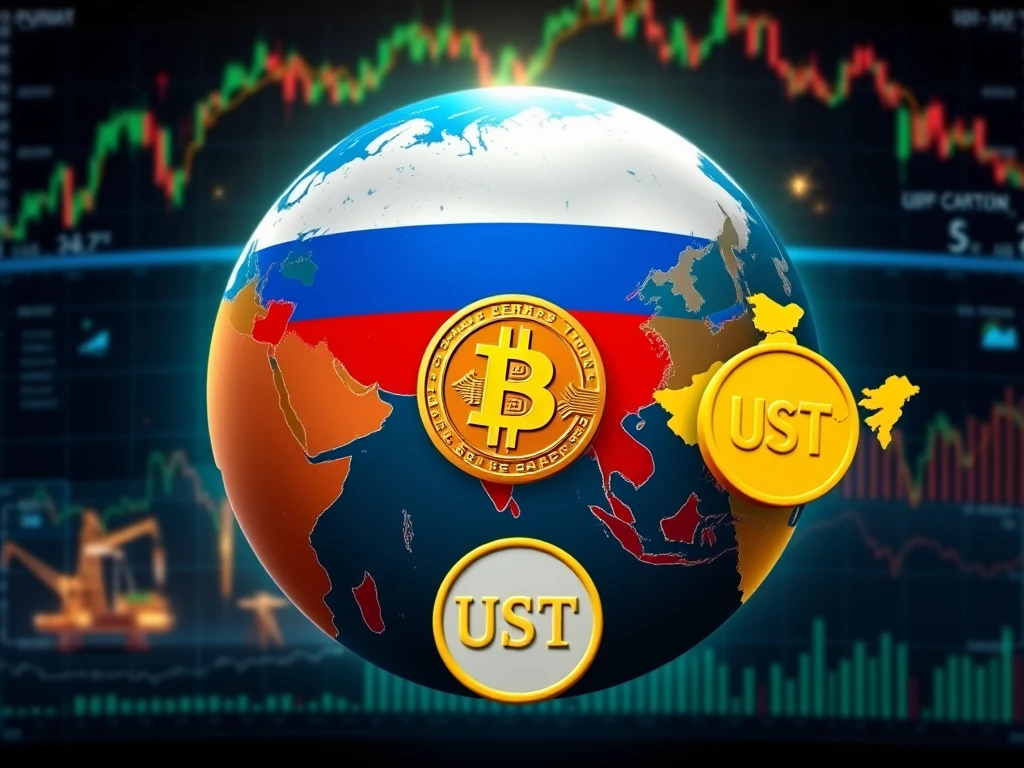Defiant Russia Leverages Bitcoin for Secret Oil Trades with China and India

In a stunning revelation highlighting the evolving landscape of international finance, reports have emerged indicating Russia’s strategic utilization of cryptocurrencies, specifically Bitcoin and Tether (USDT), to facilitate oil trades with China and India. This bold move comes amidst the backdrop of stringent global sanctions, showcasing crypto’s potential to reshape geopolitical financial strategies. Let’s delve into how Russia is reportedly navigating these turbulent waters using digital assets.
Russia’s Bold Bitcoin and USDT Play for Oil Trades: Circumventing Sanctions
According to a recent Reuters report, Russian oil companies are ingeniously employing Bitcoin (BTC) and USDt to maintain and even accelerate international trade with key partners like China and India. This development, revealed by sources with direct insight into the matter, underscores the increasing relevance of cryptocurrencies in bypassing traditional financial restrictions. One source mentioned a significant volume, with a Russian oil trader processing tens of millions of dollars monthly through digital asset transactions. While the Russian Finance Minister hinted at the possibility of using Bitcoin for foreign trade back in 2025, the current scale and application in critical sectors like oil are newly reported and noteworthy.
Unpacking the Mechanism: How Russia’s Crypto Oil Trade Works
The report details a fascinating, albeit complex, process involving intermediaries to execute these crypto-based oil trades. Here’s a simplified breakdown of the reported mechanism:
- Middlemen Step In: The process hinges on middlemen who operate offshore accounts, acting as crucial facilitators in these transactions.
- Local Currency Payment: A Chinese buyer, for example, pays for Russian oil in yuan to a trading company acting as this middleman. This payment is deposited into an offshore account.
- Crypto Conversion: The middleman then converts the yuan into crypto assets, primarily Bitcoin or USDT, effectively moving the value outside traditional banking rails.
- Transfer and Ruble Conversion: The cryptocurrency is transferred to another account, which then forwards it to a third account within Russia. Finally, within Russia, the crypto is converted back into Russian rubles, completing the transaction cycle.
This intricate system underscores the lengths to which nations might go to maintain trade flows in the face of economic pressures and sanctions. It also highlights the inherent decentralization and borderless nature of cryptocurrencies as tools for international finance.
Sanctions or No Sanctions: Crypto’s Persistent Role in Russia’s Trade
An intriguing insight from a Reuters source suggests that the use of crypto in Russia’s foreign oil trading isn’t merely a temporary workaround due to sanctions. The source indicates that crypto is perceived as a fundamentally “convenient tool” that “helps run operations faster.” This implies a potential long-term shift towards incorporating digital assets into international trade practices, regardless of the geopolitical landscape. Even if sanctions were lifted and traditional dollar-based transactions became freely available again, the efficiency and speed offered by crypto could make it a preferred method for some.
Broader Crypto Developments in Russia: Legalization for High-Net-Worth Individuals
This news arrives alongside another significant development in Russia’s crypto policy. The Bank of Russia has officially proposed legalizing cryptocurrency investments, but with a caveat – this is currently intended for high-net-worth individuals. To qualify, individuals must possess at least $1.1 million in securities and deposits. This move signals a potentially nuanced approach to crypto regulation in Russia, possibly aiming to control and benefit from crypto adoption while mitigating risks. It also suggests a growing acceptance of digital assets within certain segments of the Russian financial system.
Key Takeaways: Russia, Crypto, and the Future of Global Trade
- Sanctions Evasion: Cryptocurrencies like Bitcoin and USDT are being actively used to bypass international financial sanctions, particularly in critical sectors like oil trade.
- Geopolitical Implications: This development could have significant geopolitical ramifications, potentially weakening the impact of sanctions and altering global trade dynamics.
- Crypto Utility in Trade: It showcases the real-world utility of cryptocurrencies beyond speculative investments, demonstrating their role in facilitating international transactions, especially in challenging circumstances.
- Regulatory Evolution: Russia’s evolving stance on crypto, including potential legalization for wealthy individuals, indicates a complex and potentially strategic approach to digital assets.
- Future of Finance: This situation raises questions about the future of international finance and the role of decentralized technologies in reshaping global trade and economic power.
Conclusion: A Paradigm Shift in Global Finance?
Russia’s reported use of Bitcoin and USDT for oil trades with China and India is more than just a news story; it’s a potential paradigm shift in how international trade and sanctions are navigated in the digital age. As nations explore innovative financial tools to overcome geopolitical hurdles, the role of cryptocurrencies in global finance is set to become increasingly prominent and complex. This developing story warrants close attention as it unfolds, potentially setting new precedents for international trade and the future of economic sanctions. The strategic embrace of crypto by a major global player like Russia could indeed signal a significant evolution in the global financial landscape, forcing a re-evaluation of traditional economic and political strategies.
This is a developing story, and further information will be added as it becomes available.









